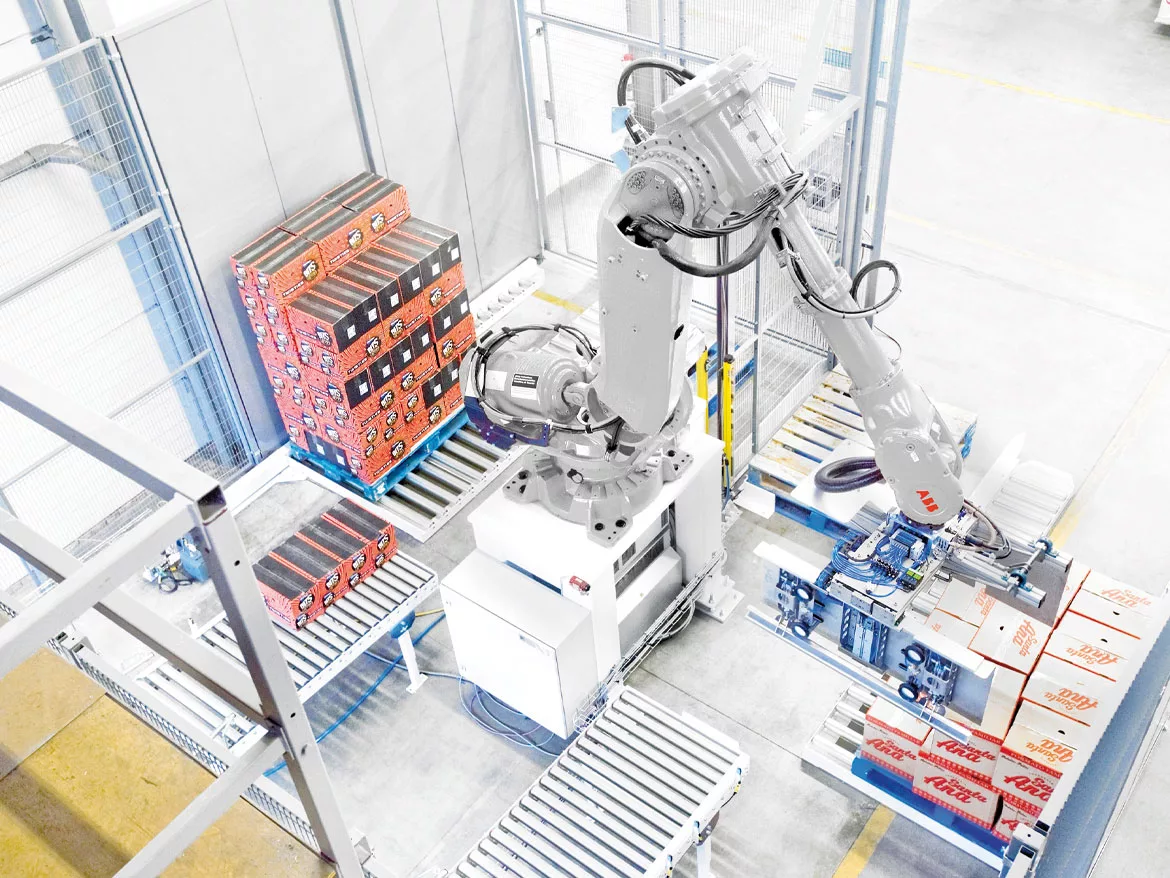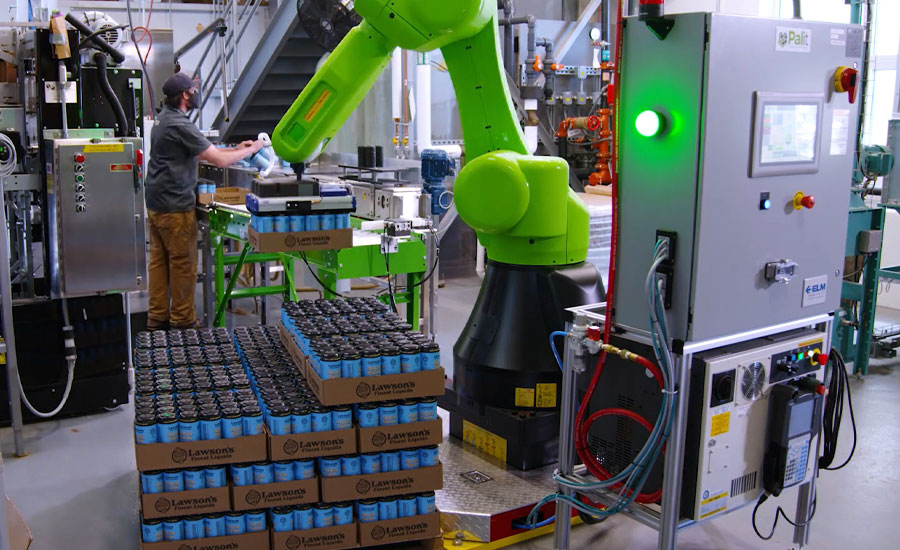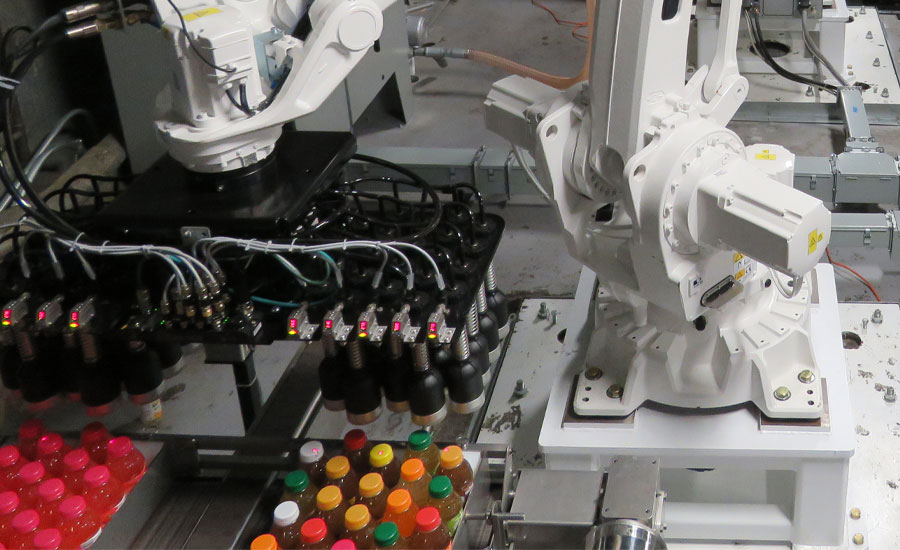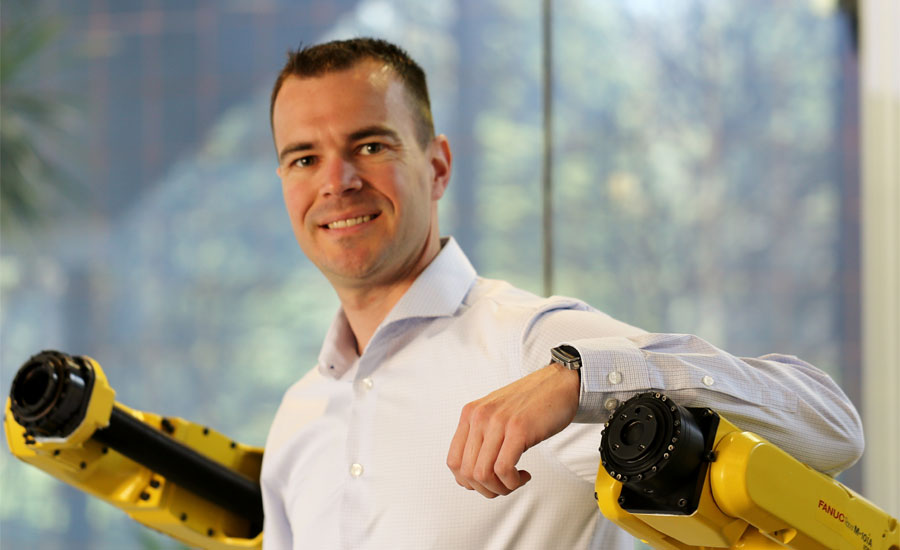Warehouses benefit from flexibility robots provide in picking, packing
AI vision systems improve speed for beverage operations

To streamline operations in the warehouse, robotics handle repetitive tasks such as picking, packing and palletizing.
Image courtesy of ABB Robotics
In the 1963 screwball comedy, “It's a Mad, Mad, Mad, Mad World,” teams of comedic stars including Milton Berle, Jonathan Winters, Ethel Merman and Buddy Hackett hysterically race each other to find $350,000 of stolen loot buried under a Big “W” some 200 miles away. Within busy beverage warehouses crippled by a lack of workers, robotics are the “buried treasure” that provide beverage manufacturers, distribution centers and logistics warehouses the tools they need to seamlessly move SKUs from point A to point B.
Mark Joppru, vice president of robotics and automation at ABB Robotics, Auburn Hills, Mich., notes that the growth of omnichannel retailing has led to more warehouse operations transforming their systems to handle pallets and packaging destined for retail shelves, while also picking and packing highly varied items for shipping direct to individual consumers.
“A significant driver for change has been the growth of direct-to-consumer (D2C) and direct-to-store (D2S) shipping, which is dramatically changing the way that consumers order and collect products,” Joppru says. “With these new models, consumers have an expanding choice of methods for receiving orders in addition to home delivery, which is becoming increasingly environmentally and economically unsustainable as more people shop remotely. These methods include click and collect, in-store collection and, more recently, robotic street kiosks, where shoppers pay for and receive the product of their choice.

Image courtesy of Lawsons Finest and Elm Electica
“Operators need the right infrastructure for maximum flexibility that can pick and handle a wide variety of goods in the widest range of combinations and in the shortest possible time,” he continues. “Advances in technology, including robot speed and payload, as well as AI enabled by vision systems, will give customers the unprecedented ability to recognize and handle a greater variety of products in a more agile and flexible way.”
Within the beverage industry, robots are crucial for three main areas: picking, where products are picked and loaded to primary packages or machinery; packing, where products are loaded to secondary packaging (such as a carton or case); and palletizing, loading/unloading fully packaged products to/from pallets, according to Joppru.
Easy-to-use programming software, end of arm tooling and function packages provide enhancements to base robots that enable flexibility of choice to suit the full range of beverage industry automation needs.
On the beverage side, strong consumer demand for variety packs and more sustainable packages are driving the need for traditional robots and cobots, says Wes Garrett, senior account manager and authorized system integrator sales for packaging and fulfillment at FANUC America.
The Rochester Hills, Mich.-based company is seeing more beverage products being produced on high-speed lines with bottles moving so quickly that it’s nearly impossible to touch a single bottle as it moves down a line.
“Beverages are typically handled in groups, which does allow [speed] rates to be lower; however, payloads and speeds still make it challenging to use cobots,” Garrett says. “We have found cases in smaller craft breweries where cobots can actually keep pace to palletize canned products. Unfortunately, cobots are not a good fit for large-scale beverage manufactures.”
The more easily programmable cobots are designed to work alongside human employees and are capable of “learning” on the job, while industrial robots handle repetitive tasks and enable employees to be reassigned to safer, more rewarding tasks.
ABB Robotics’ Joppru also points to the rise in cobots and improved safety software.

Image courtesy of ABB Robotics
The company’s dual arm YuMi robot and their SafeMove, a safety certified monitoring software that allows for more efficient and flexible production scenarios, permits normal high speed and high payload operation for most of the time. However, when occasional human intervention is needed, the robot will slow down and stop and then continue working as the operator leaves the cell.
“As there is no physical guarding this permits rapid intervention and almost completely removes the risk of critical stoppages due to human interaction,” Joppru explains. “[Our robot monitoring software] provides tools that speed the commissioning workflow for faster setup and validation.
“For example, if an operator needs to interact with the robot system, safety sensors can be incorporated into the robot cell to detect the person’s presence,” he continues. “After detection, SafeMove will either supervise the robot’s speed or monitor it while it is standing still. Once the person clears the zone, the robot can resume operation.”
Greater flexibility, efficiency with speed
Robotics technologies and automation can improve operational efficiencies and help companies reduce costs and improve profit. Although the initial cost of ownership might be high, the return-on-investment (ROI) is even higher, particularly as robotics provide flexibility, reliability, repeatability, guaranteed uptime and consistent production.
This is particularly crucial as consumers demand an ever-increasing number of variants on store shelves. And with the flavors expanding in alcohol and non-alcohol formats, robotics easily can handle picking and packaging for these diverse portfolios. “The upsurge of flavored products means a higher level of flexibility is needed in the manufacturing areas due to the number of variants and pacing formats with low volume, high mix now the new normal,” ABB Robotics’ Joppru says. “This is a perfect scenario for robotics with the high level of flexibility they bring and the ability to change programs immediately when required, facilitating rapid changeover.”
Most warehouses already have at least one robot, as the technologies get proven for their applications, they typically deploy larger scale throughout the warehouse, FANUC America’s Garrett says.
“Robotics easily integrate to all types of automation solutions. Integrators utilize PLC’s to tie everything together seamlessly,” he says. “They solve all types of problems including throughput, trackability, labor shortages, etc. We consistently help beverage companies automate by partnering them with experienced Authorized System Integrators. The integrator provides them with a turnkey robot solution for applications such as palletizing and packing. These solutions boost the DC’s [overall equipment effectiveness], throughput and uptime with attractive ROIs.”
Robotic technology continues to evolve “with faster arms, greater intelligence with force sensing and vision, [and] more variants (payload/reach/environmental adaptations),” Garrett adds.
Articulated (4- to 6-axis) and delta robots are the most common robots used, while collaborative robots are becoming more popular, ABB Robotics’ Joppru says.
He points out that developments in digital technologies and AI are the new enablers for robotic usage in current and developing areas.
“Robotics typically ensure consistent throughput on lines and help improve yield, reduce waste and remove inconsistencies from the line as well as reducing the need for human intervention, which slows or stops production lines,” he explains. “By removing labor, and reassigning employees to more rewarding jobs away from heavy and difficult operations, there is a vast improvement in operator safety and a reduction in injuries.”

Wes Garrett, senior account manager and authorized system integrator sales for packaging and fulfillment at FANUC America
To support these operations, ABB offers solutions for AI warehouse order fulfillment. For example, its 6-axis GoFa CRB 15000 Collaborative Robot is designed to safely work directly and continuously alongside humans and to be very easy to install and use. GoFa will help businesses automate processes involving heavier loads and longer reaches to assist workers with repetitive and ergonomically challenging tasks.
The company also recently partnered with Berkeley, Calif.-based Covariant to bring AI-enabled robotics solutions to market and to accelerate the company’s expansion into the distribution and eCommerce sectors with fully autonomous warehouse order fulfilment solutions.
FANUC America offers a full robotic line — more than 230 variants — designed to work in every food, beverage and industrial market with payload capabilities ranging from 0.5 kilograms to 2,300 kilograms. The line also includes cobot models and a fully integrated iRVision and force sensor line.
“In the beverage industry, the most popular robots are 4- or 5-axis models used for packing and palletizing. This means they don’t have full 6-degrees of motion, but just X, Y, Z rotation, which meets the needs of the beverage industry since it is rare that beverage products ever need to be flipped upside down,” FANUC America’s Garrett explains. “These type of robots come in a variety payloads and reaches. The benefits are lower cost, higher duty and speed capabilities.”
Although the Industrial Internet of Things (IIoT) still is evolving, customers are nevertheless taking advantage of its ability to access data to better understand their automation’s performance, Garrett adds.
Experts agree that robots for the beverage industry will continue to get faster and more intelligent to keep pace with the industry’s demands.
ABB Robotics’ Joppru concludes: “There is a real confidence that all areas of the beverage market will see robotic technology as one of the main differentiators in their operating efficiencies in the coming years, especially with low volume, high mix being the new normal. When you consider the population growth globally, the demographics alone dictate that there will be an increase in consumer demand and potentially even more variants.”
Looking for a reprint of this article?
From high-res PDFs to custom plaques, order your copy today!





